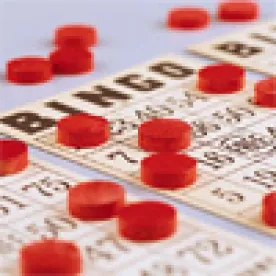In Planet Bingo, LLC v. VKGS LLC, 2013-1663 (Fed. Cir. Aug. 26, 2014) (nonprecedential), the Federal Circuit upheld a § 101 invalidity finding on summary judgment by the court below. The opinion is brief, spending only three paragraphs on the determination that the claims are “directed to an abstract idea” and an additional five on the determination that “the claims at issue do not have an ‘inventive concept’ sufficient to ‘transform’ the claimed subject matter into a patent-eligible application.”
Unfortunately for the patentee, all briefs in the case were filed before the Supreme Court’s decision in Alice Corp. v. CLS Bank International, No. 13-298 (U.S. June 19, 2014) was decided. Accordingly, when the Federal Circuit applied the two-step process defined by the Supreme Court in Alice, it did so without direct input from the parties. As a result, the opinion does not provide a thorough consideration of all relevant elements. Nonetheless, the Federal Circuit opinion is an affirmance of the lower court’s decision, and so a review of the more detailed analysis presented there may be helpful in understanding the Federal Circuit’s position.
The approach taken by Judge Bell of the Western District of Michigan was, if anything, more exhaustive than the two steps identified by the Supreme Court in Alice. To refresh, those steps were (1) determining if “[t]he claims at issue are directed to a patent-ineligible concept” such as an “abstract idea” and (2) if so, determining if the claims “transform that abstract idea into a patent-eligible invention” by supplying an “inventive concept.” To frame the discussion, an example claim is below.
7. A method for playing a game of Bingo which comprises the steps of:
(a) providing a system for managing a game of Bingo which comprises:
a computer with a central processing unit (CPU) and with a memory and with a printer connected to the CPU;
an input and output terminal connected to the CPU and memory of the computer; and
a program in the computer enabling:
(i) input of at least two sets of Bingo numbers which are preselected by a player for repetitive play in games of Bingo over a period of time;
(ii) storage of the sets of Bingo numbers which are preselected by the player as a group in the memory of the computer;
(iii) assignment of a player identifier unique to the player for the group having the sets of Bingo numbers which are preselected by the player wherein the player identifier is assigned to the group for multiple sessions of Bingo;
(iv) retrieval of the group using the player identifier;
(v) selection from the group by the player of at least one of the sets of Bingo numbers preselected by the player and stored in the memory of the computer as the group for play in a selected game of Bingo in a specific session of Bingo wherein a number of sets of Bingo numbers selected for play in the selected game of Bingo is less than a total number of sets of Bingo numbers in the group;
(vi) addition by the computer of a control number for the set of Bingo numbers which is selected by the player for play in the selected game of Bingo;
(vii) output of a receipt with the control number, the set of Bingo numbers which is selected for play in the selected game of Bingo, a price for the set of Bingo numbers which is selected for play in the selected game of Bingo, a date of the selected game of Bingo and optionally a computer identification number; and
(viii) output for verification of a winning set of Bingo numbers by means of the control number which is input into the computer by a manager of the game of Bingo;
(b) playing the game of Bingo using the set of Bingo numbers wherein the player signals a Bingo to indicate the set of Bingo numbers which is selected for play in the selected game of Bingo is the winning set of Bingo numbers; and
(c) verifying the winning set of Bingo numbers with the control number with the program.
Returning to the Alice analysis: (1) Are the claims directed to an abstract idea?
The district court determined that the claims “encompass[] the abstract idea of managing/playing the game of Bingo.” File No. 1:12-CV-219 (W.D. Mi. Dkt. 73). This determination was made with reference only to the claims themselves. Citing to Cybersource Corp. v. Retail Decisions, Inc., 654 F.3d 1366 (Fed. Cir. 2011), the court noted that processes that “consist[] solely of mental steps which can be carried out by a human using pen and paper … [are] not patentable.” At this stage, the court appears to be applying the “mental steps” test to the identified abstract idea, not to the claim itself. While no court has yet provided a clear explanation of how to define the abstract idea encompassed by a claim, this suggests that one reasonable method of doing so is to identify the portion of the claim that consists solely of mental steps.
(2) Do the claims supply an inventive concept that transforms that abstract idea into patent-eligible subject matter?
The district court held that the additional limitations “provide only for the use of a computer performing its most basic functions: storing numbers, assigning identifiers, allowing for basic inputs and outputs, printing of a receipt, displaying of numbers, and/or matching a player’s numbers with the called numbers for verification.” Accordingly, the claims failed this prong as well.
The question this raises is: How do the courts distinguish the patent-eligible process discussed in Diamond v. Diehr, 450 U.S. 175 (1981) from the patent-ineligible processes of Alice and Planet Bingo? In Diehritself, the Court held that even though the Arrhenius equation was known, and using molds to cure rubber was known, a process that used a computer to recalculate the Arrhenius equation and adjust the cure time was patent-eligible. The basis for this was the improvement of “constantly measuring the actual temperature inside the mold.” In Alice, the Court revisited Diehr and declared that the claims had been found patent-eligible because it “used a ‘thermocouple’ to record constant temperature measurements inside the rubber mold – something ‘the industry ha[d] not been able to obtain.” Accordingly the distinction appears to be that in Diehr a hardware element that was not routinely connected to computers was used to enable the process while in Alice and Planet Bingo the computer is used for its ordinary purposes. Given that thermocouples (which, it should be noted, are not actually recited in the claims) were well-known in the art even at the time of Diehr, and given that using a computer for its ordinary purposes is not sufficient to confer patent-eligibility, it is unclear why using a thermocouple (or other thermometer) for its ordinary purpose of measuring temperature should convert an otherwise ineligible method into an eligible one.
One is left wondering if the difference is simply that the final step of Diehr was curing rubber, and so was an innovation that was useful to an existing, traditional industry, while the systems of Alice and Planet Bingo are innovations that relate to finance and gambling, and so are somehow deemed less worthy of patent protection. If true, this bias finds no support in statutory law, and without explicit admission from the courts that this is the case, even legislative remedies are difficult to pursue.



 />i
/>i

